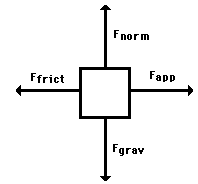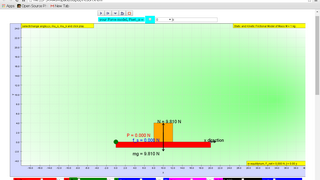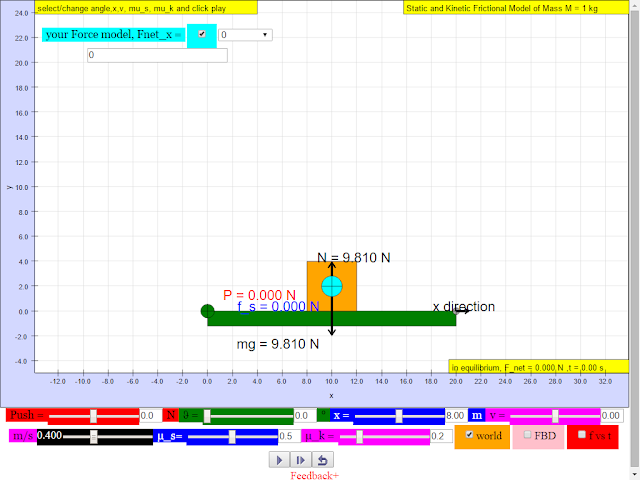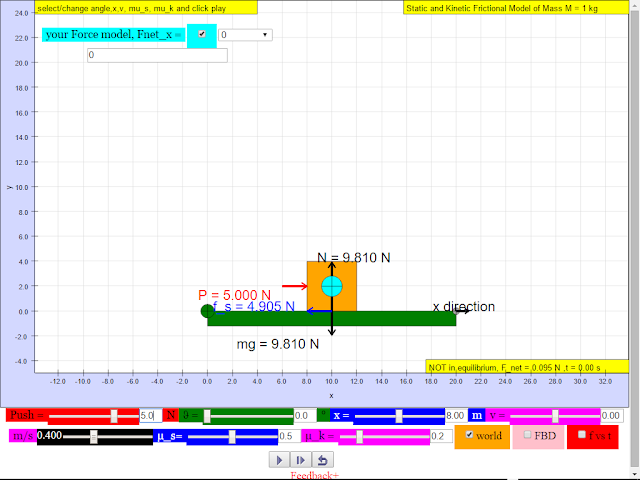About
http://weelookang.blogspot.com/2014/04/ejss-static-and-kinetic-friction-on.html
Translations
| Code | Language | Translator | Run | |
|---|---|---|---|---|
 |
||||
Credits

 This email address is being protected from spambots. You need JavaScript enabled to view it.; Francisco Esquembre
This email address is being protected from spambots. You need JavaScript enabled to view it.; Francisco Esquembre
Learning Outcomes
- To explain and understand phenomena when there is no net force acting on a stationary object, or on an object that is moving in a straight line using modelling technique [diagrammatic models, mathematical models (dynamics equations), or any set of predictive and explanatory rules/principles].
- To predict changes in motion (if any) of an object based on the forces acting on it using modelling technique [diagrammatic models, mathematical models (dynamics equations), or any set of predictive and explanatory rules/principles].
Static and Kinetic Friction Study Guide
Quiz
Instructions: Answer the following questions in 2-3 sentences each.
- What is the key difference between static and kinetic friction?
- Describe a real-world scenario where understanding static friction is crucial.
- How does the applied force affect the frictional force experienced by an object at rest?
- What happens to the frictional force when an object overcomes static friction and starts moving?
- Explain the concept of maximum static friction.
- How does the "Static and Kinetic Frictional Model" simulation help visualize Newton's First Law of Motion?
- In the simulation, how can you demonstrate that friction is independent of the contact area?
- What are some common misconceptions students have about forces, specifically related to equilibrium?
- Using the "Static and Kinetic Frictional Model," describe how you would model a scenario where a book is pushed across a table at a constant velocity.
- Explain how the added moments calculations in the simulation enhance the understanding of rotational motion in relation to friction.
Quiz Answer Key
- Static friction acts on objects at rest, preventing them from moving, while kinetic friction acts on moving objects, opposing their motion.
- Designing the grip of a car tire requires understanding static friction. The tire needs enough grip to prevent slipping when starting or stopping, utilizing static friction between the tire and the road surface.
- As the applied force increases, the static friction force also increases to match it, up to a certain limit. This keeps the object at rest.
- When the applied force exceeds the maximum static friction, the object starts moving, and the frictional force transitions from static to kinetic friction, which is generally lower than static friction.
- Maximum static friction is the highest value of static friction that can be achieved before the object begins to move. It depends on the normal force and the coefficient of static friction between the two surfaces.
- When no force is applied in the simulation (Fnet_x = 0), the block remains at rest, illustrating that an object at rest stays at rest unless acted upon by an external force.
- The simulation does not have a feature to change the contact area, highlighting that friction is independent of it. The focus is on the applied force, the type of friction, and the resulting motion.
- Some students believe that forces cease to act on an object in equilibrium, which is incorrect. Forces are still present, but they balance each other out, resulting in zero net force.
- To model a book moving at a constant velocity, you would apply a force slightly larger than the maximum static friction to initiate movement. Then, adjust the applied force to match the kinetic friction force, resulting in zero net force and constant velocity.
- The added moments calculations consider the angle of the applied force. This demonstrates how the location of the force application can affect the object's rotational tendency and whether it will slide or tip over, adding another layer of complexity to understanding friction.
Essay Questions
- Compare and contrast the characteristics of static friction and kinetic friction. Discuss their dependence on factors like surface type, normal force, and the coefficient of friction.
- Analyze the role of friction in everyday life. Provide specific examples where friction is beneficial and where it poses a challenge, and discuss strategies for managing friction in both situations.
- Explain how Newton's Laws of Motion relate to the concept of friction. Provide specific examples from the "Static and Kinetic Frictional Model" simulation to illustrate your points.
- Critically evaluate the effectiveness of the "Static and Kinetic Frictional Model" simulation as a learning tool. Discuss its strengths, limitations, and potential improvements for enhancing student understanding of friction.
- Research and discuss different types of friction beyond static and kinetic, such as rolling friction and fluid friction. Explain their unique characteristics and provide real-world examples of each.
Glossary of Key Terms
- Static Friction: A force that opposes the initiation of motion between two surfaces in contact and at rest relative to each other.
- Kinetic Friction: A force that opposes the motion of two surfaces in contact and moving relative to each other.
- Coefficient of Friction: A dimensionless value representing the roughness between two surfaces. Higher values indicate greater friction.
- Normal Force: The force exerted by a surface that supports the weight of an object resting on it, acting perpendicular to the surface.
- Applied Force: An external force exerted on an object.
- Maximum Static Friction: The highest value of static friction that can be achieved before an object begins to move.
- Net Force: The vector sum of all forces acting on an object.
- Equilibrium: A state where the net force acting on an object is zero, resulting in no acceleration.
- Newton's First Law of Motion: An object at rest stays at rest and an object in motion stays in motion with the same speed and in the same direction unless acted upon by an unbalanced force.
- Newton's Second Law of Motion: The acceleration of an object is directly proportional to the net force acting on the object and inversely proportional to its mass. (F = ma)
- Moment: The turning effect of a force about a point, calculated as the product of the force and the perpendicular distance from the pivot point to the line of action of the force.
This briefing document reviews the content from "Static and Kinetic Frictional Model of Mass M = 1 kg JavaScript HTML5 Applet Simulation Model" published on the Open Educational Resources / Open Source Physics @ Singapore website.
Overview
The document describes an interactive HTML5 applet simulating static and kinetic friction, designed for secondary and junior college levels (with a focus on dynamics). It aims to aid in understanding the characteristics and effects of forces, particularly friction, using a modeling approach.
Learning Outcomes & Key Inquiry
The applet targets the following learning outcomes:
- Understanding phenomena with no net force: Students should be able to explain scenarios where an object is stationary or moving at a constant velocity using various modeling techniques.
- Predicting motion changes based on forces: Students will learn to predict how an object's motion will change based on the forces acting on it, again utilizing different modeling methods.
The overarching question guiding this exploration is: "What are the characteristics and effects of forces in nature?"
Focus on Friction
The document specifically delves into the concept of friction:
- Definition: Friction is defined as a force that always opposes motion between surfaces in contact.
- Factors Affecting Friction: The frictional force on a horizontal plane is influenced by:
- The materials in contact
- The surfaces in contact
- The force pressing the surfaces together
- It is independent of the contact area.
Addressing Misconceptions
The document acknowledges common misconceptions students have regarding forces:
- Active vs. Passive Forces: Students often believe only living things can exert forces, neglecting forces from inanimate objects.
- Resultant Force: The concept of the resultant force determining the direction of motion is often misunderstood, with students focusing on the strongest individual force.
- Force as a Property: Students may incorrectly perceive force as a property of an object that gets "used up."
- Equilibrium: The idea of forces ceasing to exist at equilibrium is a misconception. Also, the tension in a string is not simply the sum of forces at each end.
Interactive Simulation & Activities
The heart of the resource is the interactive simulation. The document outlines various activities using the simulation:
- No Net Force Model: Students explore scenarios where no force is applied and understand the resulting lack of motion.
- Maximum Static Friction Model: Students experiment with increasing applied force, observing how the static frictional force increases to match it until a threshold is reached.
- Overcoming Static Friction Model: Students apply a force exceeding the maximum static friction, initiating motion and observing the transition to kinetic friction.
Big Idea and Further Exploration
The document emphasizes that these activities highlight Newton's Second Law (F = ma), showing that acceleration requires a non-zero net force.
Beyond the core activities, the document provides additional resources:
- Moments Calculations: The simulation incorporates calculations for moments, illustrating how the object remains stationary or starts rotating based on the applied force and angle.
- External Links: Links are provided to related simulations and resources from sources like PhET and OPhysics.
Overall, this resource leverages an interactive simulation to deepen understanding of static and kinetic friction. It aims to challenge common misconceptions and provide a hands-on experience to illustrate Newton's Second Law.
Key inquiry question: What are the characteristics and effects of forces in nature?
1. & 2. Types of force and its effects • Friction always opposes the motion between the two surfaces in contact. The frictional force between two surfaces on a horizontal plane depends on the material in contact; surfaces in contact; force pressing the two surfaces together; independent of area of contact.
Students’ prior knowledge of Forces
Primary level:
Students learn that a force:
• may be a push or a pull that acts on an object, e.g. magnetic force and gravitational force (forces that act at a distance), elastic spring force and frictional force (only when objects are in contact).
• can move a stationary object; speed up, slow down, change the direction or stop a moving object; and change the shape of objects.
Students conduct simple experiments to investigate the effects of friction on the motion of objects and forces on springs (mass on spring system), and learn how friction can be useful and can also be a problem.
Lower secondary level:
Students learn that:
• a force (push or pull) is exerted when one thing interacts with another, e.g. gravitational force, frictional force and magnetic force.
• forces affect the state of rest or motion and the size and shape of a body (unit: newton) and the type of force will have different effects on an object.
Students’ common misconceptions and learning difficulties in Forces
Forces between masses, charges and magnets:
Students often think that:
• only active agents (usually living things) exert forces and cause motion, whereas passive forces by inert objects (e.g. a table) do not exist;
• an object moves in the direction of the strongest force rather than the direction of the resultant force; and force is a property of an object and gets used up.
Equilibrium of forces:
Students often think that:
• at equilibrium, forces cease to act on the object; and
• the tension in a string is the sum of the forces acting on each end.
Worksheet
- ejss_model_friction Dynamics - student worksheet (2017).docx
- Dynamics - student worksheet (gwf - dl - wlk).docx
- Dynamics - student worksheet (gwf - dl).docx
- Dynamics - student worksheet (lyna).docx
Video
Frictional force modelling with simulation activity by lookang lawrence wee
Imagine you put a playing card on top of a cup, then a coin on top of the playing card. Quickly pull the playing card away. What will happen to the coin? Explain your answer. Watch the video at http://tinyurl.com/ast2016-1 and check your prediction
Newtons 1st Law-coin and glass by Nick Alsleben
Engage for Newton's 1st Law
Imagine placing a strip of tape on the floor. Then you ask a friend to run towards you from about 30 meters as fast as possible and to stop exactly on the tape. What will happen to your friend when he or she tries to stop? Explain your answer
Suggested answer:
What you demonstrated in your two thought experiments, is Newton’s First Law. It states that
“an object will remain at rest or in uniform motion in a straight line unless acted upon by an external force.”
In case 1 (video above), the coin stayed in place, as the card was pulled away so fast, that friction did not act. In case 2 (engage for newton's 1st law), your friend had some forward motion, that could not be removed immediately.
Pre Modeling Activity
In this activity, you will be asked to draw forces in diagrams. Forces are usually indicated by arrows. The length of the arrow tells us how strong a force is: the longer the arrow, the larger the force.
In the example, we see two vertical forces acting on a Wooden Block resting on a slope. Its Fgrav= Weight is pulling it down and Fnorm = contact force on block by slope, an upward force. The Ffrict is the frictional force arising when there is a Fapp = Push to the right. The fact that the arrows are equally large, tells us that the two forces have the same magnitude. 
Modeling Activity
Modeling Activity using this #html5 simulation
No Net Force (no Push Force )Model
Tom has just been promoted and is pushing a file cabinet down the hall to his new office. He begins by looking at the file cabinet and considers how to best go about his task. Select Fx = 0 to model the zero force model. Note the motion of the block is no change in position and velocity is zero all the time.
Activity 1: Using the model builder, select Fnet_x = 0 to simulate this effect
No Net Force ( 0<|Push| => Maximum Static Friction) Model
He then begins pushing on the file cabinet, which, at first, does not move at all. To simulate this case, select Push to be 3 N and observe what happens to the motion of the block. Note that the Push is cancel out by the Friction Force. Even at Push = 4.905 N is balanced out by Friction Force and the block does not move.
Activity 2: Using the model builder, select Fnet_x = 0 to simulate this effect
Just Enough Push force (Push> Maximum Static Friction) to move Model
He pushes it slightly harder than the maximum static friction, and it is sliding . Thus, applying a Push force just larger than 4.905 N, the object begins to slide. But at t >0, the Friction becomes Kinetic Friction.
Eventually the file cabinet begins to slide across the floor, slowly moving towards his new office with acceleration.
Activity 3: Using the model builder, select Fnet_x = 3.038 to simulate this effect. note that the static force is just a force to overcome initial when v = 0, after |v|>0, kinetic friction replaces as the frictional force.
Big Idea
Thus, the evidences and model building process above suggests the condition of acceleration is the presence of non zero net force, which is F = ma, Newton's Second Law.
Misconceptions
Students may think that it is possible to experience is pushing the file cabinet, and it is moving to the right with constant velocity.
Added Moments Calculations
as suggested by workshop participant from JJC, moments are calculated and reflected in simulation!
 |
| angle = 0, block does not rotate https://sg.iwant2study.org/ospsg/index.php/interactive-resources/physics/02-newtonian-mechanics/02-dynamics/42-friction |
 |
| angle = 45, block does not rotate, normal contact force shifts to the extreme lower end of the block, just in position to not rotate clockwise.https://sg.iwant2study.org/ospsg/index.php/interactive-resources/physics/02-newtonian-mechanics/02-dynamics/42-friction |
 |
| angle > 45, block rotates (but not simulated), normal contact force shifts beyond the extreme lower end of the block, in real life, block will rotate clockwise.https://sg.iwant2study.org/ospsg/index.php/interactive-resources/physics/02-newtonian-mechanics/02-dynamics/42-friction |
Video
https://notebooklm.google.com/notebook/c65d1d82-a34a-4c9e-bbbd-809582b9a79f/audio
Versions
- http://weelookang.blogspot.sg/2016/02/frictional-block-free-body-diagram-with.html BlogPost by lookang with added moments calculations.
- http://weelookang.blogspot.com/2014/04/ejss-static-and-kinetic-friction-on.html BlogPost by lookang
- Sliding Down an Incline Plane Model by Francisco Esquembre http://www.compadre.org/osp/items/detail.cfm?ID=9973
Other Resources
- http://phet.colorado.edu/en/simulation/legacy/forces-and-motion Forces and Motion by PHET
- http://physics.bu.edu/~duffy/HTML5/static_friction.html Exploring static friction by Andrew Duffy
- http://ophysics.com/f1.html by This email address is being protected from spambots. You need JavaScript enabled to view it.
- http://ophysics.com/f2.html by This email address is being protected from spambots. You need JavaScript enabled to view it.
Friction FAQ
1. What is friction?
Friction is a force that opposes motion between two surfaces in contact. It arises from the microscopic irregularities of the surfaces, which interlock and resist sliding.
2. What are the types of friction?
There are two main types of friction:
- Static friction is the force that prevents an object from moving when a force is applied to it. It is the force you need to overcome to get an object to start moving.
- Kinetic friction is the force that acts on a moving object, slowing it down. It is generally less than static friction.
3. What factors affect the force of friction?
The force of friction depends on several factors:
- The types of surfaces in contact: Rougher surfaces have higher friction than smoother surfaces.
- The force pressing the surfaces together: The harder the surfaces are pressed together, the greater the friction.
- Whether the surfaces are moving relative to each other: Static friction is greater than kinetic friction.
4. How does friction affect the motion of objects?
Friction can have both positive and negative effects on the motion of objects.
Positive effects:
- Friction enables us to walk and run without slipping.
- Friction allows cars to accelerate, brake, and turn.
Negative effects:
- Friction can cause wear and tear on surfaces.
- Friction can generate heat, which can be wasteful or even dangerous.
5. What is Newton's First Law of Motion, and how does it relate to friction?
Newton's First Law of Motion states that an object at rest will stay at rest, and an object in motion will stay in motion at a constant velocity unless acted upon by an external force. Friction is an example of an external force that can change an object's state of motion.
6. How can friction be reduced?
Friction can be reduced by:
- Using smoother surfaces: Polishing or lubricating surfaces reduces friction.
- Using bearings or rollers: Bearings and rollers allow surfaces to roll over each other rather than slide, reducing friction.
- Reducing the force pressing the surfaces together: Lighter objects experience less friction than heavier objects.
7. How can friction be increased?
Friction can be increased by:
- Using rougher surfaces: Texturing or adding grip to surfaces increases friction.
- Increasing the force pressing the surfaces together: Heavier objects experience more friction.
8. What are some common misconceptions about friction?
- Friction only occurs when objects are moving: Static friction acts on stationary objects to prevent them from moving.
- The area of contact affects the force of friction: For most practical purposes, the area of contact has little effect on the force of friction.
- Force is a property of an object and gets used up: Force is an interaction between objects, and friction is a force that arises from this interaction. Force is not a property that an object possesses or that gets used up.
- Details
- Parent Category: 03 Motion & Forces
- Category: 02 Dynamics
- Hits: 18356














